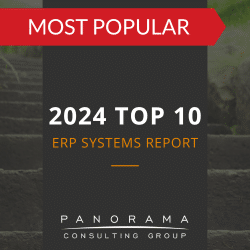Increasingly, manufacturers are planning digital transformation initiatives to improve their operational performance. While these projects come with obvious advantages, there are many challenges of digital transformation in manufacturing.
Today, we’re looking at a few of the key issues that can lead to ERP failure or missed opportunities in this industry.
5 Challenges of Digital Transformation in Manufacturing
1. The Cost of Initial Investments
Large enterprises typically have the budget and bandwidth required to embrace new digital solutions. However, small and medium sized manufacturers often lack the means to pursue those same goals. These organizations might decide to stick with legacy systems, especially if there aren’t any obvious pain points associated with them.
If you’re in this situation, you may want to rethink your legacy systems. Digital transformation can help you stay competitive, and a proven methodology can ensure you stay on budget.
With the right strategy, SMB manufacturers can make smart investments that deliver benefits that surpass the initial investment. Examples include:
• Improved operational efficiency
• Reduced downtime
• Ability to make more data-driven decisions
A Failed Payroll System Implementation
Panorama’s Expert Witness team was retained to provide a forensic analysis and written report to the court regarding the failed implementation of a major software developer’s ERP/payroll system.
2. Cybersecurity Challenges
Any digital transformation journey involves clearly defining how you will manage existing cybersecurity protocols and how your new system will change these protocols.
To understand which areas of your business are the most vulnerable, you should perform three key tasks:
1. Identify mission-critical information assets
2. Create business process roadmaps that show how that data travels throughout the organization
3. Determine the risks accrued if that information was lost, damaged, or compromised
Step 2 should involve two separate maps. The first will depict the current information flow, while the second will incorporate updates based on any new technologies or business process reengineering work.
3. Lack of Digital Expertise
It’s no secret that smart manufacturing is still a relatively new concept.
As such, many manufacturing leaders may not understand the inner workings of some of the latest developments, such as:
• Process automation
• Advanced data analytics
• Cloud based computing
• Industrial internet of things (IIOT)
• Digital twin technology
• Machine learning
• Artificial intelligence
• Zero-trust models
This lack of direct knowledge can impede progress, but it isn’t a reason to avoid digital transformation altogether. Those in the manufacturing industry who lack relevant technical expertise can find guidance from an independent ERP consultant who can leverage their industry and technical knowledge to guide technology purchases.
4. Inflexible Legacy Infrastructure
Modern manufacturing technologies, like the top manufacturing ERP systems, are robust, but they are not always compatible with a company’s existing infrastructure.
One of the keys to avoiding software integration problems in digital transformation projects is to ensure that you have a team of experienced software experts on your side. You may also want to consider hiring a project auditing expert to review your implementation approach. These experts know what issues to look for as they regularly work alongside computer software expert witnesses who’ve “seen it all.
Clearly, legacy infrastructure can be difficult to replace, so we recommend starting small and discussing where digital technologies can have the greatest impact. For example, features that enable predictive maintenance may be one of your top priorities, as this can have a significant return on investment (ROI).
5. Employee Pushback and Resistance
A manufacturer could heavily invest in digital transformation only to find that it didn’t achieve the anticipated results. When this happens, the issue isn’t always technical. In many cases, the issue is related to the people and processes behind the technology.
It’s common for employees to resist change. Often, this comes down to fear. Team members begin to realize that their jobs may become obsolete or change beyond recognition.
They also realize that they have a huge learning curve ahead of them. With the click of a button, they could make a wrong move that holds serious consequences.
Encouraging employees to work past these concerns may require a total shift in company culture. If your organization isn’t the type to celebrate and embrace change, then don’t expect employees to start today. Culture shifts take time.
We recommend establishing a continuous improvement culture where employees are motivated to speak up when they see opportunities for improvement. This puts them in the right mindset to embrace the changes wrought by a digital transformation.
At the same time that you’re transforming your culture, you should be focusing on organizational change management. This will not only help you change your culture, but it will prepare employees to embrace the specific changes that will affect them.
Avoiding Digital Transformation Failure
Manufacturers around the world are looking for ways to increase their agility when it comes to responding to changing market conditions and changing customer needs. As they adopt new digital technologies, they are finding they can serve dynamic customer needs more efficiently than ever before.
These manufacturers didn’t get there by taking shortcuts, though. Instead, they were aware of the challenges of digital transformation in manufacturing, and they were keen on finding the expertise necessary for navigating project complexities.
Our ERP consulting team is here to help you avoid failure by anticipating all the challenges you may encounter. Contact us below for a free ERP consultation.















